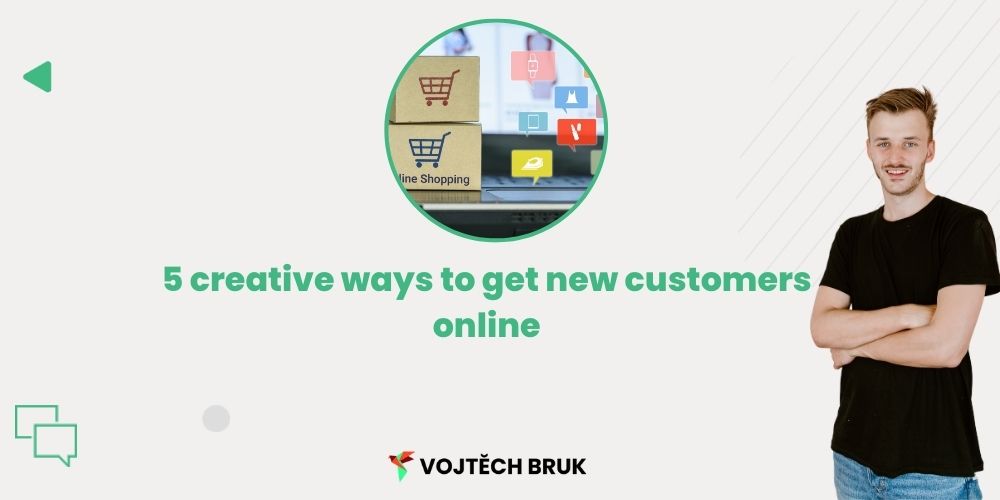Getting new customers is the goal of many websites, but often their owners wonder how to do it after launching.
1. Newsletter
In my opinion, the newsletter is still the golden grail of marketing. It’s effective as hell, personal and immortal. I’m sure I’m slightly biased, but I’ve had such a good experience with it that I can’t really do otherwise.
Try it too and you’ll see.
2. Proactive addressing
This method is particularly suited to individuals, smaller agencies and generally people solving specific problems for specific customers.
Direct outreach (cold outreach) has a very bad reputation. Who would also tout spam emails containing a message that a company will make you a new website for half the price and you’ll get a keychain as a gift. You know the email has gone to 100 other addresses and if it’s already in your inbox, you automatically delete it.
But there is another way. I’ll try to illustrate it for you with my business, which is web development.
- Research – First, I would write down all the possible places I could help people. In the case of websites, I would choose industry + location (for example, construction companies + Brno) and make a list of everyone I think I could help.
- Personalized outreach – Many people send uniform emails because they think it costs too much time and work to “personalize” emails. They are wrong. Yes, it does cost some time. However, it also costs some time to write non-personalized emails – albeit less. It’s always about efficiency. And even if it takes 10x (estimated) longer to write a personalized email than an unpersonalized one, the return can easily be 100x – 1000x higher – especially considering that in many industries (web development is certainly one of them), a single customer can pay for an entire outreach campaign. Let’s take a look at the numbers, which I’ll try to make as reflective of my experience and reality as possible. Let’s say you sell an item/service that makes you £3000 profit when you sell it: Uniform email -> time to write 2 hours -> sent to 100 addresses (01:33 average time per email) -> 2% response rate -> 2 leads -> we’ll make a deal with half of them -> 3000 Kč profit for Personalized Email campaign -> skeleton writing time 2 hours + 10 minutes personalization each (11.33 minutes each) -> sent to 100 addresses -> 40% (last time I tried) response rate -> 40 leads -> we agree with half of them -> 60,000 Kč profit (2000% / 200x difference compared to non-personalized campaign). Numbers are always hard to estimate, but it’s a matter of principle. In my experience, personalization has always paid off royally. If you don’t feel like typing, I recommend making short personalized videos using Loom or at least use software like YAMM, Snovio or Lemlist to personalize your emails at least at the level of dynamic fields. P.S. Spam campaigns can also ruin your reputation, both in the classic sense (people will remember and say so) and in the online sense (Google will degrade the deliverability of your emails to Gmail inboxes, for example). These hidden costs of “spam” should also always be kept in mind.
3. Establishing Cross-Collaboration
Find out who works with the same customer segment as you, but fulfills a different need or solves a different problem for them.
If you have a car insurance business, the same customer segment but a different problem is solved by, for example, car dealerships, car rental companies… These are all places with whom you can arrange interesting and mutually beneficial collaborations (win-win).
If you are a hairdresser, you can approach a beautician, a wellness studio or a massage parlour. If you are a copywriter, you can reach out to an SEO speacialist, web agency or translator.
Investing energy and diligence in this direction is definitely worthwhile.
- think of 3 industries you could cross collaborate with,
- list 100 people/companies from that industry you would like to collaborate with,
- reach out to them with an offer
It looks like a lot of work. And yes, I can assure you, it is an extreme amount of work. However, if you try to do it, there’s a solid chance that by the end of your “career”/company life, you’ll have no shortage of contracts. At worst, you’ll just end up with a passive funnel of potential customers.
I think that’s worth a try.
4. Table of Contents
Content is not now taken to mean articles, videos and promotional material – that is, what is commonly considered content. Rather, by content, I mean advice.If we’re going to follow the example of my business again, it would probably be important for me to be mainly in Facebook groups, since that’s where people solve problems with the site most often.
I would try
- be as helpful as possible,
- follow groups regularly,
- not sell anything to the people I help directly.
I would then try to follow this three-point checklist in all other places where people solve problems (forums, live meetings, discussions under YouTube videos, etc.).Long term, I would also try to direct people to my Discord, where I can be sure they can ask me anything at any time, and it’s also a platform I can then use to let the world know what I’m doing.
5. Giving things away for free
On the internet (especially the Czech one) it is still rather common that when you get something for free, you feel that it really hurts the giver. If it’s not exactly a discount coupon, but some content (ebook, course, email series) it often feels like it really hurts the giver to give these things away for free, and they look like it.
They’re often short, unoriginal, unhelpful, and generally stilted. Do it differently. First of all, remember that free is never nothing.When people give you an email for “free content,” they are often giving you the opportunity to end up “earning” the content many times over than if you had paid for it directly with money.
This is why I wouldn’t be afraid to invest in “free content”. Massively. It will always pay you back.
I personally tried this strategy when I did a Advent Web Challenge, which gave me a lot of hours of work, but was worth an email to people – which, as I hinted, is definitely not free.
However, it was a great payoff for me and I highly recommend giving it a try, as I think it can pay off for you as well.
These 5 creative ways have always worked well for me. Let me know in the comments how they work for you, or if and what experience you have with acquiring new customers!





